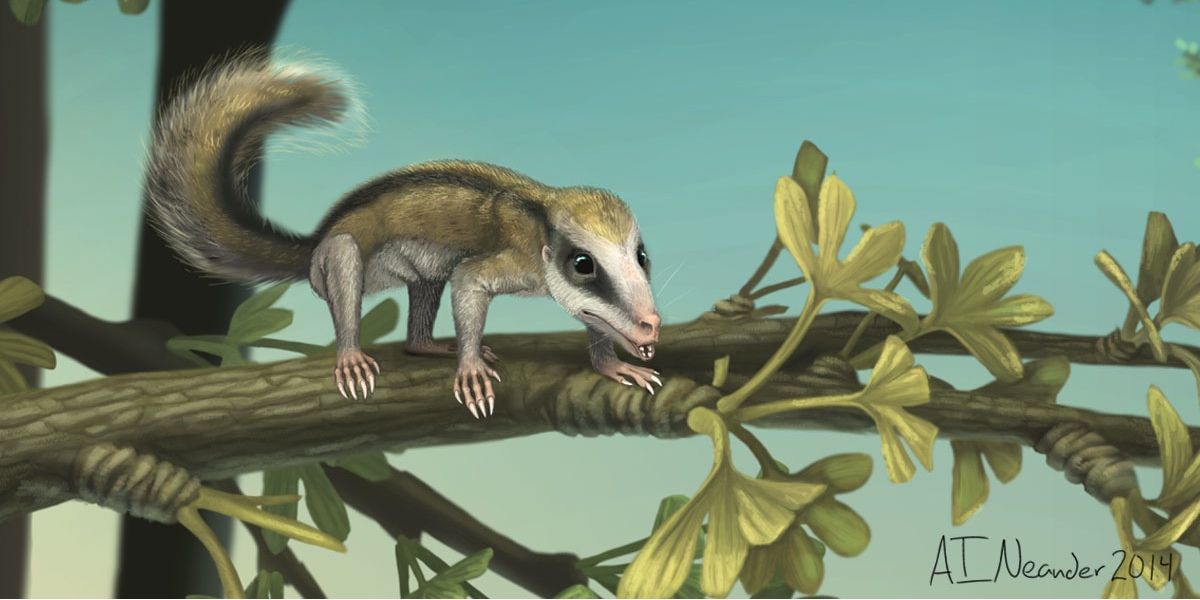2 Jurassic Mini Mammal Species Discovered in China

Dinosaurs may have dominated the planet during the Jurassic Period, but they shared the landscape with little rodentlike creatures. Two new species of these pocket-size early mammals have been discovered in China — one was a horny-clawed tree-dweller, and the other was a tunnel-digger with shovel-like paws.
Researchers say these new specimens show that early mammals, though small, were surprisingly diverse.
Agile tree climber and its burrow-dwelling cousin
One of the newly discovered creatures, now known as Agilodocodon scansorius, is the earliest tree-dwelling mammal ever found. It had several features that made it fit for climbing: long claws, spadelike front teeth to chew into bark, and flexible elbows and ankles. At most, it might have weighed about 40 grams (1.4 ounces). [See Images of the Newfound Mammal Ancestors]
It lived in a temperate climate zone on the supercontinent Laurasia, surrounded by lush plants and lots of insects on the hilly shores of a lake, where it probably met an unlucky end. One day, it perhaps fell from a treetop and into the lake, where it drowned and, over time, became entombed in the sediment settling on the bottom.
Fast-forward 165 million years, and that lake bed has long dried up. It now lies within the borders of Inner Mongolia, where a fossil-hunting farmer found the creature's remarkably well-preserved skeleton in 2011.
This fossil-rich lake deposit, known as the Daohugou Formation, has already yielded dozens of extinct creatures from the Jurassic Period: a beaverlike swimming mammal, feathered dinosaurs known as Anchiornis, pterosaurs and prehistoric salamanders. When Zhe-Xi Luo, a professor of organismal biology and anatomy at the University of Chicago, saw Agilodocodon, he was amazed by its state of preservation.
Sign up for the Live Science daily newsletter now
Get the world’s most fascinating discoveries delivered straight to your inbox.
"When we got into the study of Agilodocodon, we realized that the outline for the horny sheath of the claws is preserved," Luo told Live Science. "Those soft tissues are not preserved in the vast majority of mammals. It has a very long, curved narrow claw — one feature to show that it is a good climber."
The second creature, Docofossor brachydactylus, was also found by a fossil hunter — this time, in the 160-million-year-old lake deposits of the Ganggou Fossil Site in China's Hebei province, in 2012. Docofossor was even smaller than Agilodocodon — it probably stood just 3.5 inches (9 centimeters) tall and weighed up to 17 grams (0.6 ounces), the researchers said. The earliest underground-dwelling mammal ever found, Docofossor might have been similar to an African golden mole, with short, wide digits good for digging.
Earliest history of mammals
Both of these fossils came to the Beijing Museum of Natural History still encased in slabs of stone. Luo and his fellow researchers at the museum and the University of Chicago authenticated the provenance of the fossils, and they've been studying the specimens for almost two years. Today (Feb. 12) they published two reports describing the fossils in the journal Science.
The two fossils belong to an order of extinct mammals known as Docodonta, which share a common ancestor with modern mammals. Before the latest discovery, scientists mostly knew about docodonts from fossils of teeth, jaws and other bits of skulls. Previously, Luo said, scientists only had skeletons from the bodies of two docodonts: Castorocauda, the beaverlike swimming mammal found at Daohugou, and Haldanodon, another extinct small mammal found in a coal mine in Portugal in the 1970s. [See Images of Mammals Through Time]
"What's new with this discovery of two additional docodonts is that one of them turns out to be a subterranean mammal with highly specialized digit patterns; the other is a bona fide excellent tree climber," Luo said. "From their locomotory functions, we can safely infer that docodonts' ecological diversity had a tremendous range — far more so than we previously anticipated."
Luo thinks the fossils suggest that early groups of mammal, like docodonts, were able to fill a variety of ecological niches even with dinosaurs around. And these creatures adapted to their environment in the same ways as modern mammals.
Other scientists who weren't involved in the studies agreed.
"The two papers contribute substantially to the new picture of Mesozoic mammals as highly diversified," said Thomas Martin, a paleontologist at the University of Bonn in Germany. "The old picture of generalized, 'primitive' creatures is no longer valid. They lived in the shadow of the dinosaurs, but they apparently flourished in that niche."
But one thing about the picture of mammals from the Mesozoic Era (which includes the Jurassic Period) still hasn't changed: These animals were small. Martin noted that the largest known mammal from this time is still the aforementioned Castorocauda, which had an estimated body mass of about 1.75 lbs. (0.79 kilograms). Mammals grew large only after the mass extinction event that wiped out the dinosaurs 65 million years ago.
David Krause, a professor of anatomical sciences at Stony Brook University in New York, said the discovery of such diversity among early mammals suggests one of two possibilities: that early mammals originated even earlier than scientists thought, or that they diversified very quickly. The only way to find out which option is right is to find more fossils — not only in China but in other parts of the world, Krause said in an email.
Follow Megan Gannon on Twitter. Follow us @livescience, Facebook& Google+. Original article on Live Science.
